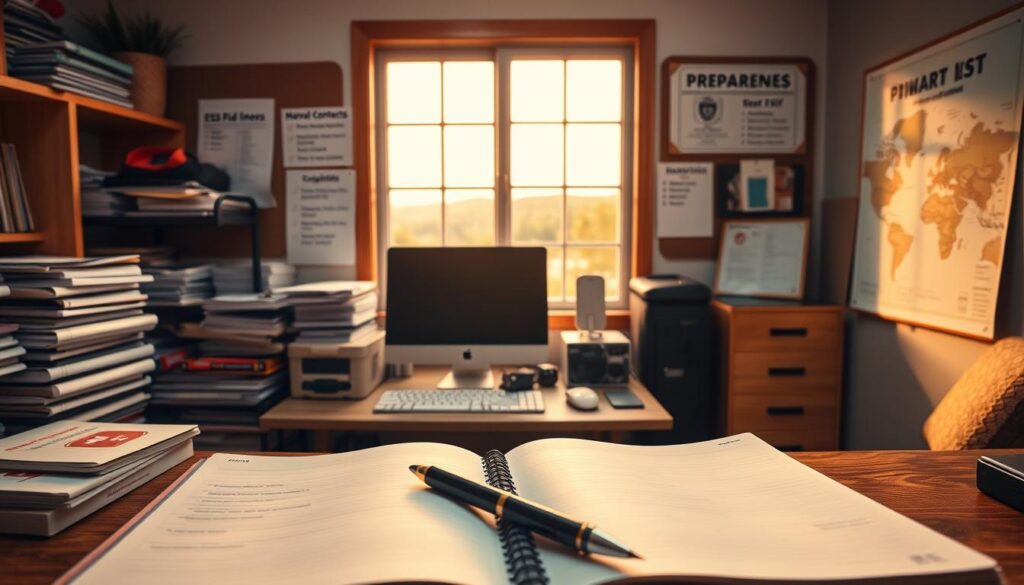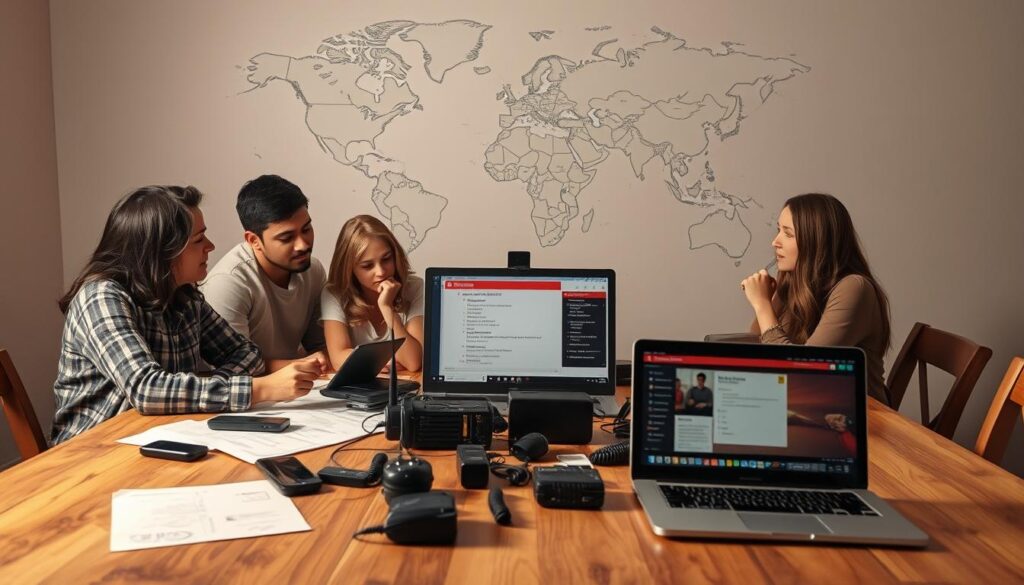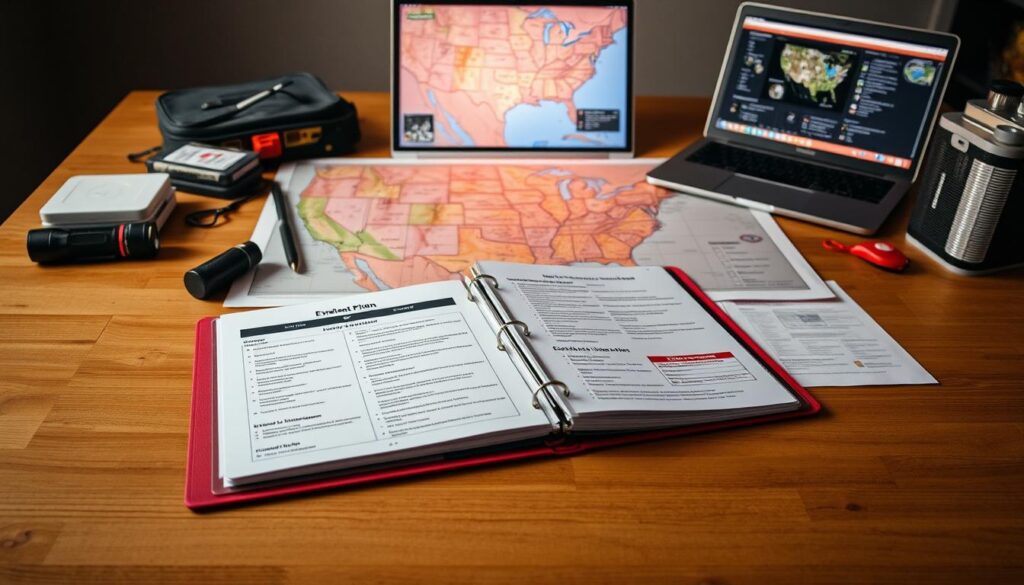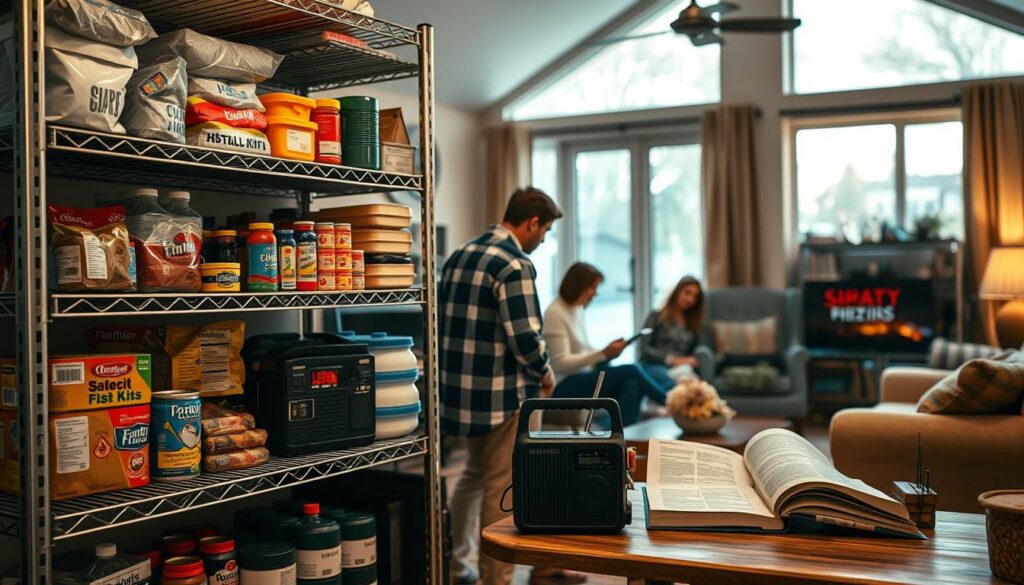Disasters can happen anytime, leaving families alone and at risk. I remember when a sudden disaster hit my family, showing how vital a plan is. Being ready isn’t just about having stuff; it’s about having a clear plan to keep your family safe and in touch.
It’s key to know what disasters might hit your area. Having a family meeting spot and a way to stay in touch is very important. A good emergency plan can save lives and lessen stress during unexpected times. Start making a plan today to protect your loved ones.
Key Takeaways
- Understand the types of disasters that could affect your area.
- Establish a family meeting place that’s familiar and easy to find.
- Plan how you’ll contact one another if separated.
- Make a plan today to ensure your family’s safety.
- Review and update your plan regularly.
Understanding Preparedness Planning
Disaster readiness starts with knowing how to plan for emergencies. It means being ready and having a plan to handle crises well. Planning for emergencies involves thinking ahead and having strategies to lessen their effects.
What Is Preparedness Planning?
Preparedness planning is making a detailed plan for emergencies and disasters. It’s about spotting possible dangers, figuring out risks, and finding ways to lessen their effects. This is key to making sure people and families can deal with emergencies well.
A good plan includes knowing how to react to emergencies like natural disasters and power outages. It also means having the right stuff and supplies to keep my family and me safe during these times.
The Importance of Being Prepared
Being ready is key to managing crises well. With a solid plan, I can act fast and safely in emergencies, keeping my family and stuff safe. Planning ahead also helps cut down the cost and emotional toll of disasters.
Being prepared lets me take charge in emergencies, making smart choices and keeping my family safe. It’s about being proactive, not just reacting.
By getting into preparedness planning, I can boost my readiness for disasters and crises. This makes sure my family is safer and more resilient in the future.
Assessing My Risks and Needs
Understanding my personal risks and needs is key to a good preparedness plan. I must look at different factors that could affect my household.
Identifying Potentia Hazards
I first identify hazards in my area, like natural disasters or accidents. For example, if I live where floods are common, I need to get ready for them. It’s important to know the hazards, how likely they are, and how they might affect my home.
Some hazards to think about include:
- Natural disasters like earthquakes, hurricanes, or wildfires
- Technological accidents such as chemical spills or nuclear incidents
- Health emergencies like pandemics or widespread disease outbreaks
Evaluating My Community Resources
Next, I look at the resources in my community for dealing with these hazards. I find out where emergency shelters, hospitals, and other key places are.
Community Resources Checklist:
| Resource | Location | Contact Information |
|---|---|---|
| Emergency Shelter | 123 Main St | (555) 123-4567 |
| Local Hospital | 456 Elm St | (555) 901-2345 |
| Emergency Management Office | 789 Oak St | (555) 789-0123 |
When I assess my risks and needs, I also think about my household’s specific needs. This includes my family, pets, and any medical equipment or care needed. This way, I can make my preparedness strategies fit my family’s needs.

Building a support network is also important. I look for people who can help with communication, taking care of kids, and other tasks during emergencies. With a strong contingency planning plan, my household can face any hazard.
Creating a Comprehensive Emergency Kit
A good emergency kit is key to any emergency plan. It helps me and my family stay safe during disasters or emergencies.
It’s important to pack essential items. These include water, food, and first aid supplies.
Essential Items to Include
A basic emergency kit should have a few important items. These are:
- Water (one gallon per person per day for several days, for drinking and sanitation)
- Food (at least a several-day supply of non-perishable food)
- Battery-powered or hand crank radio and a NOAA Weather Radio with tone alert
- Flashlight
- First aid kit
- Extra batteries
- Whistle (to signal for help)
These items help meet basic needs during emergencies.
| Item | Purpose | Quantity |
|---|---|---|
| Water | Drinking and sanitation | 1 gallon per person per day |
| Non-perishable food | Sustenance | Several days’ supply |
| First aid kit | Medical emergencies | 1 kit |
Personalizing My Kit for My Family
It’s important to make my emergency kit fit my family’s needs. This means thinking about pets, seniors, or people with disabilities.
For pets, I should pack their food, water, and any needed medicine. If there are seniors or people with disabilities in my home, I need to include their specific needs. This could be extra medication or medical equipment.

By making my emergency kit fit my family’s needs, we can all be better prepared for emergencies.
Understanding the Basics of Crisis Management
Effective crisis management is key to protecting your business from unexpected challenges. It involves a series of steps to prepare for and respond to crises. This approach helps maintain stability and trust with your customers and stakeholders.
Defining Crisis Management
Crisis management is a set of strategies and actions taken to manage and mitigate the impact of a crisis. It includes identifying risks, creating a crisis management plan, and training teams to respond effectively. This proactive approach helps your business stay resilient and adapt to changing situations.
Importance of Crisis Management
Implementing crisis management is vital for your business’s survival and growth. It ensures that you are prepared to handle any unexpected event, minimizing its impact. By having a solid crisis management plan, you can protect your reputation, maintain customer trust, and ensure business continuity.
Key Components of Crisis Management
A successful crisis management plan includes several key components:
- Risk Assessment: Identifying and evaluating the risks your business faces.
- Communication: Developing clear and timely communication strategies to keep stakeholders informed.
- Training: Ensuring that your team is equipped with the necessary skills to respond effectively during a crisis.
- Recovery: Having a plan to restore normal operations and minimize long-term damage.
By focusing on these components, you can enhance your crisis management efforts and protect your business from unforeseen challenges.
Communicating with My Family and Loved Ones
A key part of emergency preparedness is having a good communication plan. It’s hard to reach family and friends during emergencies because of busy or broken lines.

To keep everyone connected, create a plan. This should include safe meeting spots and an emergency contact outside your area.
Setting Up a Communication Strategy
A good plan has several important parts. First, pick two meeting spots. One should be near your home for quick escapes, like fires. The other should be farther away, in case you can’t go back home or need to leave.
- Choose a meeting spot outside your home but within your neighborhood.
- Select another meeting spot outside your neighborhood in case you need to evacuate.
- Ensure all family members understand the meeting places and know how to get there.
Establishing Emergency Contacts
Also, pick an emergency contact person who lives far away. This could be a relative or friend. It’s easier to call or text them when local lines are busy.
- Choose a reliable contact person who is not in your immediate area.
- Make sure all family members have this contact’s phone number saved.
- Discuss with your family how to use this contact person as a reference point during an emergency.
With a solid communication plan, your family can handle emergencies better.
Staying Informed About Emergencies
Being ready for emergencies means knowing about possible dangers. It’s key to have a good way to get updates and alerts quickly.
Utilizing Local Alerts and Warnings
Signing up for local alerts is a smart move. Many places have systems that send messages about dangers. You can sign up on your local government’s website or through the emergency management agency.
For more tips on staying informed, check out https://www.ready.gov/be-informed.
Following Trusted News Sources
It’s also important to follow trusted news sources. I should choose reliable news outlets for the latest info. This includes local and national news, as well as online sites.
By staying connected, I can keep up with weather, natural disasters, and other emergencies. Knowing about these risks helps me plan better for disasters.
Reviewing and Drills
It’s key to check and practice my emergency plan often. This makes sure it works well and everyone knows their part. It’s important for my family to know what to do in a crisis.
First, I practice the plan with my family. We go over as much of it as we can. This helps us find any weak spots or things we can do better. It’s important that everyone in the house knows what to do.
Conducting Emergency Drills
Drills are great for a few reasons:
- They show us where our plan might not be good enough
- They help us get better at responding quickly
- They make sure we can talk clearly with each other
- They make us feel more confident in our plan
Adjusting My Plan Based on Feedback
After drills, I ask everyone for their thoughts. This helps me make my plan better. It becomes more useful and easy to follow.
Some things I check and change include:
- How we talk to each other
- Our escape routes and where to go
- That our emergency kit is ready and easy to get to
By keeping up with my emergency plan, my family and I are ready for anything. This boosts our crisis management skills.
Updating My Preparedness Plan Regularly
I know my preparedness plan needs to change with my life. It’s important to update it often. This means checking my risks, refreshing my emergency kit, and updating my evacuation plan when needed.
To keep my plan current, I must regularly check my situation. When to Reassess My Plan is key. I should look over my plan yearly or when big changes happen, like moving or having more family members.
Reassessing My Needs
Checking my needs means making sure my emergency kit is ready. I should ensure canned food is in a cool, dry spot. Boxed food should be in sealed containers. And, I must replace expired items to keep them useful.
Incorporating New Information
Adding new info and resources to my plan is essential. This means keeping up with the latest preparedness strategies and contingency planning methods. This way, my plan stays strong and I’m always ready.
By updating my plan often, I’m confident I can handle emergencies. This ongoing effort keeps me alert and ready for any situation.
Final Thoughts on Preparedness Planning
Thinking about being prepared makes me realize how key it is. Having a plan tailored to you is essential for disaster readiness. Knowing the dangers in your area and having a full emergency kit can keep your family safe.
Building Resilience Through Preparedness
Being prepared means being proactive, not just reacting to disasters. It’s about knowing what to do, having a plan, and staying alert. I can make a plan today, knowing my family might not be together if disaster hits.
Take the First Step Today
I urge you to begin making your own preparedness plan today. Find out what disasters could hit your area and get ready. With Preparedness Planning, you can build resilience and keep your loved ones safe.
FAQ
What is preparedness planning, and why is it important?
Preparedness planning means making a plan to keep your family safe in disasters. It’s key because disasters can happen without warning. Having a plan helps reduce risks and ensures a quick response.
How do I assess my personal risks and needs for emergency preparedness?
First, think about the dangers you face and what resources are available in your area. Also, consider your family’s special needs, like supplies for pets or seniors. This helps you make a plan that fits your family.
What are the essential items to include in my emergency kit?
Your kit should have food, water, first aid, and ways to communicate. Make sure to add items your family needs, like pet supplies or special care for seniors.
How do I develop an effective evacuation plan?
Find safe routes and places to go, plan how to get there, and think about your pets. This ensures a safe and quick move during an emergency.
Why is communication important during emergencies, and how can I set up a communication strategy?
Keeping in touch is vital to know everyone is safe. To communicate, list emergency contacts, pick meeting spots, and choose an out-of-area contact.
How can I stay informed about emergencies and potentially dangerous situations?
Use local alerts and follow reliable news. This keeps you updated on dangers and helps you prepare.
Why is it essential to review and practice my emergency plan?
Drills help make sure your plan works and spot areas to improve. This ensures a quick and safe response in emergencies.
How often should I update my preparedness plan?
Update your plan often to include new info and resources. Also, review it when your situation changes, like moving or having a new family member.
What are some key considerations for crisis management and contingency planning?
Think about crisis management strategies, like having a backup plan and identifying risks. Also, plan for unexpected events to be ready for anything.
How can I ensure my emergency kit remains relevant and effective?
Check and update your kit regularly. Consider expiration dates and adjust it as your family’s needs change.



